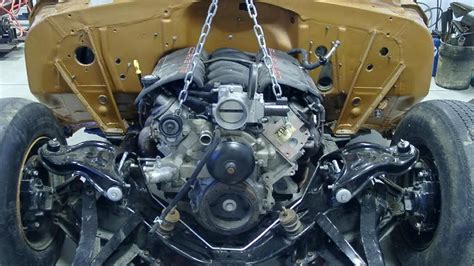Discover the essentials of LS engine mounts, their types, benefits, and installation tips to enhance your vehicle’s performance.When it comes to upgrading or swapping engines, the LS engine stands out as a popular choice among automotive enthusiasts. However, a successful LS swap hinges on more than just the engine itself; the right engine mounts play a crucial role in ensuring stability, performance, and safety. In this blog post, we will explore the world of LS engine mounts, discussing what they are and the various types available in the market. We’ll highlight the benefits of using LS engine mounts, and guide you through key factors to consider when making your selection. Finally, we will walk you through the installation process to help you achieve a seamless fit for your engine setup. Whether you’re a novice or a seasoned mechanic, this comprehensive guide will equip you with the knowledge needed to make informed decisions for your LS-powered project.
What are LS engine mounts?
The LS engine mounts play a crucial role in ensuring the stability and functionality of an LS engine, particularly when it is swapped into vehicles that were not originally designed to house this powerful engine series. These mounts are typically crafted from durable materials such as rubber, polyurethane, or a combination of both, which provides effective vibration dampening while still maintaining a secure attachment between the engine and the vehicle’s chassis.
Furthermore, the design of LS engine mounts often includes specific features that accommodate the unique weight distribution and dimensions of the LS engine family, allowing for improved engine alignment and reduced strain on vehicle components. Custom-made or universal mounts are available to facilitate easier installation and adaptability to various makes and models, making them a popular choice for enthusiasts looking to enhance their vehicle’s performance.
In summary, understanding what LS engine mounts are and how they function not only helps in appreciating the engineering behind a vehicle’s performance but also aids in making informed decisions when it comes to selecting the right mounts for your specific application, ensuring a seamless fit and optimal performance.
Types of LS engine mounts
When it comes to the world of performance vehicles and engine swaps, understanding the various types of LS engine mounts is absolutely crucial, as these mounts not only serve to secure the engine but also significantly influence the overall performance and dynamics of your vehicle.
There are primarily three significant categories of LS engine mounts that enthusiasts should consider, namely rubber mounts, polyurethane mounts, and solid mounts, each offering distinct characteristics that can suit different driving styles and applications.
| Type of Mount | Material | Key Features | Ideal For |
|---|---|---|---|
| Rubber Mounts | Natural Rubber | Soft, vibration absorbent | Daily driving, comfort |
| Polyurethane Mounts | Polyurethane | Durable, slightly firmer | Street and track applications |
| Solid Mounts | Aluminum or Steel | Minimum movement, maximum stability | Racing, performance builds |
In summary, each of these LS engine mount types plays a vital role in determining how the engine interacts with the chassis and, by extension, how the vehicle performs in terms of handling, acceleration, and overall driving pleasure, making it essential for anyone considering a swap or upgrade to carefully evaluate their options.
Choosing the right type of LS engine mount can be a daunting task, but understanding the specific needs of your vehicle—whether it’s for everyday use or high-performance racing—will ultimately guide you toward making an informed decision that enhances your driving experience.
Benefits of using LS engine mounts
The benefits of using LS engine mounts in automotive applications are manifold, as these mounts not only provide structural integrity and stability but also enhance the overall driving experience by minimizing vibrations and harshness, which is particularly beneficial for those who often engage in high-performance driving or engine swaps. This is largely due to their robust design and use of high-quality materials that offer superior durability compared to traditional engine mounts.
Furthermore, the use of LS engine mounts is essential for the optimization of engine placement, allowing car enthusiasts and professionals alike to achieve an ideal center of gravity and reduce the overall weight in certain areas, which can drastically improve handling and performance on the track or the road. Moreover, many LS engine mounts come with additional features that facilitate easier installation and adjustability, allowing for a more customizable fit tailored to specific vehicle configurations or performance goals.
In addition to these performance enhancements, another significant advantage of LS engine mounts is their compatibility with various aftermarket components, which opens up a world of opportunities for upgrades and modifications that can enhance both the vehicle’s aesthetics and functionality. For those who frequently work on their cars or participate in racing, installing these mounts can lead to fewer maintenance issues over time due to their reliable, low-we
Factors to consider when choosing LS engine mounts
When it comes to selecting the right LS engine mounts, there are several critical factors that car enthusiasts and builders must consider in order to ensure optimal performance and durability, including the material construction of the mounts, compatibility with specific LS engine models, and the intended usage of the vehicle.
One of the foremost considerations is the material from which the mounts are made, as common options include rubber, polyurethane, and billet aluminum, each of which offers distinct benefits; for example, while rubber mounts provide excellent vibration dampening and a smooth ride, polyurethane mounts offer greater stiffness and performance advantages for more aggressive driving scenarios.
Additionally, it’s essential to pay attention to the compatibility of the engine mounts with your specific LS engine variant, as using incorrectly matched mounts could lead to premature wear or failure, potentially causing severe engine instability and damage, while installation ease is also a paramount factor, ensuring you choose mounts that align well with your existing setup to avoid unnecessary complications during the installation process.
Installation process of LS engine mounts
Installing 5.3 LS engine mounts can significantly enhance the performance and stability of your engine, and while the task may initially seem daunting, with careful preparation and the right tools, the process can be quite straightforward; it is essential first to gather the necessary materials, which typically include a socket set, wrenches, a jack, jack stands, and of course, the new LS engine mounts that you will be installing.
To begin the installation, start by securely lifting the front of the vehicle using the jack and place jack stands underneath to ensure stability; once the vehicle is raised, it’s imperative to remove the old engine mounts, which involves locating the bolts that secure them in place, carefully unbolting them, and then gently sliding the old mounts out, taking caution to support the engine to prevent any stress on the transmission or wiring harness.
Once the old mounts are removed, you can now position the new LS engine mounts, ensuring that they align correctly with the engine block and chassis; after aligning the mounts, you will need to bolt them in place, following the torque specifications provided by the manufacturer to guarantee the mounts are securely fastened, and finally, after double-checking the alignment, you can lower the vehicle and test for proper fit and engine stability.
Frequently Asked Questions
What are LS engine mounts?
LS engine mounts are specifically designed brackets that secure an LS engine in place within a vehicle, ensuring stability and proper alignment.
Why are LS engine mounts important?
They are crucial for maintaining engine positioning, reducing vibration, and ensuring that the engine operates efficiently without damaging surrounding components.
What materials are LS engine mounts typically made of?
LS engine mounts are usually made from rubber, polyurethane, or aluminum, each providing varying levels of strength and vibration dampening.
How do I choose the right LS engine mounts for my vehicle?
Choosing the right mounts depends on your vehicle’s specifications, intended use, and desired level of vibration isolation; consider consulting with a specialist for personalized advice.
Can I install LS engine mounts myself?
Yes, if you have basic mechanical skills and tools, you can install LS engine mounts yourself; however, it’s important to follow detailed instructions to ensure proper alignment.
What are signs of worn out LS engine mounts?
Signs include engine vibrations felt in the cabin, noticeable movement of the engine during acceleration or braking, and misalignment of the engine in the engine bay.
How often should LS engine mounts be replaced?
It’s generally recommended to inspect LS engine mounts every 50,000 miles, but the replacement interval can vary based on driving conditions and modifications.





